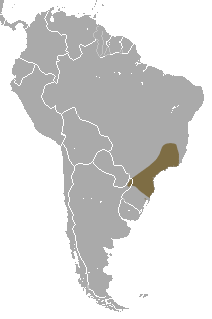Brazilian gracile opossum
| Brazilian gracile opossum | |
|---|---|
 |
|
| Gracilinanus microtarsus. Stuffed specimen | |
| Scientific classification | |
| Kingdom: | Animalia |
| Phylum: | Chordata |
| Class: | Mammalia |
| Order: | Didelphimorphia |
| Family: | Didelphidae |
| Genus: | Gracilinanus |
| Species: | G. microtarsus |
| Binomial name | |
|
Gracilinanus microtarsus (Wagner, 1842) |
|
 |
|
| Brazilian gracile opossum range | |
The Brazilian gracile opossum (Gracilinanus microtarsus) is a species of small opossum from Brazil.
Brazilian gracile opossums are relatively small opossums, with males ranging from 86 to 129 centimetres (34 to 51 in) and females from 81 to 116 centimetres (32 to 46 in) in head-body length. The tail is between 30 and 50% of the head-body length. Males weigh 17 to 52 grams (0.60 to 1.83 oz) and females from 12 to 37 grams (0.42 to 1.31 oz).
The opossum is reddish dark brown or grey over most of its body with paler, cream-colored, underparts. The fur on the face is also relatively pale, with distinct rings of near black fur around each eye. The tail is prehensile and scaly, and does not store fat as it does in some related species. The toes are relatively long, with small, regular, claws. The female typically has fifteen teats, although the exact number can vary; four are on the chest, and the remainder, including a single median teat, on the abdomen.
The Brazilian gracile opossum is found only in Brazil, being endemic to the south-eastern parts of the country, from Espirito Santo to Rio Grande do Sul. It inhabits rainforests and partly deciduous forests scattered in the southern regions of the cerrado ecoregion, but, being able to forage successfully on the ground, is less affected by fragmentation of forest habitats than more purely arboreal animals. It has also been found in artificial plantations.
There are no recognised subspecies.
Brazilian gracile opossums are arboreal and nocturnal, spending the day nesting in tree hollows. They are solitary animals, with each individual inhabiting a home range of anything from 0.03 to 0.32 hectares (0.074 to 0.791 acres), depending on habitat. Males tend to have larger home ranges than females, presumably because, being larger, they require more food.
The species is insectivorous, and is an opportunistic forager, not specialising in any particular kind of insect. Individuals have also been reported to eat some spiders, snails, and even fruit (including passionfruit). Predators of Brazilian gracile opossums include ocelots, oncillas, crab-eating foxes, maned wolves and white-tailed hawks.
...
Wikipedia

